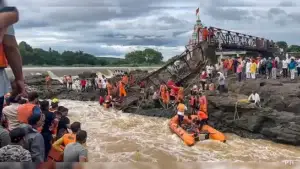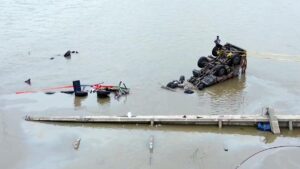Bridge Collapse Impact: Environmental Fallout, Safety Gaps & What Must Change
🔍 1. Why This Topic Matters
Bridge collapses are becoming alarmingly frequent due to aging infrastructure, rapid urbanization, and extreme weather events. These incidents don’t just disrupt transportation—they damage ecosystems, pollute air and water, and pose serious threats to human life.
Several regions across India have experienced major bridge failures in the last two years, bringing attention to gaps in safety, inspection, and environmental preparedness. This article explores the environmental consequences, risk assessment practices, pollution control strategies, real-world examples, and preventive actions needed to protect both people and nature.
🌿 2. Environmental Damage from Bridge Collapses
2.1 Habitat Destruction
Bridge collapses can dump debris like concrete, steel, and asphalt into rivers and wetlands. This smothers aquatic life, destroys fish breeding grounds, and damages shoreline vegetation critical for biodiversity.
2.2 Water Quality Pollution
Leaching of heavy metals and construction chemicals raises turbidity and alters pH levels in water bodies. These pollutants reduce dissolved oxygen, putting aquatic ecosystems at risk.
2.3 Air Pollution
Bridge failures and demolition activities release particulate matter (PM₂.₅ and PM₁₀), endangering respiratory health. Nearby homes, hospitals, and schools are particularly affected by dust and debris dispersion.
2.4 Soil Contamination
Spilled chemicals and fallen debris seep into surrounding soil, particularly in floodplains and agricultural zones. This leads to crop toxicity and long-term degradation of fertile land.
2.5 Ecosystem Fragmentation
A collapsed bridge can block animal movement corridors and disrupt natural migration paths. Riverbanks and wetlands may become inaccessible, resulting in habitat loss.
🛠 3. Risk Assessment for Bridge Collapse Prevention
3.1 Structural Integrity Audit
Routine inspection of bridge components—like piers, bearings, and cables—is critical. Advanced tools such as ultrasonic scanning and infrared imaging help detect internal damage.
3.2 Load Analysis
Comparing designed load capacity with current traffic—especially overloaded freight—can prevent stress failures. Dynamic loads from wind, seismic activity, and water flow should also be considered.
3.3 Environmental Stress Testing
Simulations for floods, earthquakes, and cyclones can predict how a bridge will react to extreme conditions. Climate-related stress factors must be included in planning and retrofitting.
3.4 Material Aging & Maintenance Records
Bridges degrade over time. Corrosion, rust, fatigue, and microbial attack reduce structural strength. Maintenance logs help track repairs and identify recurring issues.
3.5 Risk Matrix Evaluation
Assigning risk levels based on likelihood and impact helps prioritize interventions:
- Low: Minor defects requiring monitoring
- Medium: Corrosion or material wear needing repairs
- High: Structural failure risk needing immediate closure
🛡4. Pollution & Safety During Bridge Collapse
4.1 Dust & Airborne Pollution
Use of water-spraying systems and dust collectors during demolition helps reduce air pollution. Workers must wear respirators and all machinery should have emission-control systems.
4.2 Waterborne Contamination
Silt curtains and floating booms prevent debris from spreading in rivers. Sedimentation filters and temporary check dams reduce downstream contamination.
4.3 Noise & Vibration Control
Demolition should be restricted to daylight hours. Low-noise machinery and sound-dampening techniques help reduce disturbances. Ear protection must be provided to workers and nearby residents.
4.4 Hazardous Waste Handling
Hazardous materials like treated wood, rubber sealants, or electrical cables must be segregated and handled separately. Licensed disposal and tracking is essential.
4.5 Worker Safety Protocols
Strict safety protocols are required on-site. Workers must be equipped with PPE such as helmets, gloves, harnesses, and high-visibility clothing. Emergency zones, evacuation plans, and regular safety drills should be mandatory.
⚠5. Preventive Measures & Precautions
5.1 Regular Maintenance Schedule
Bridges should be inspected semi-annually or annually based on location and usage. Minor issues like joint cracks or loose fasteners should be fixed immediately to avoid bigger problems.
5.2 Structural Health Monitoring (SHM)
SHM systems use sensors to detect real-time stress, vibration, corrosion, and temperature changes. Alerts enable faster decision-making and timely repairs.
5.3 Load & Traffic Management
Weigh-in-motion systems and real-time monitoring help enforce load limits. Dangerous or overweight cargo should be rerouted from older or vulnerable bridges.
5.4 Flood & Earthquake Resilience
Bridges must be designed or retrofitted for increased flood heights, water flow velocities, and seismic activity. Scour-resistant foundations and seismic bearings improve durability.
5.5 Environmental Protection Planning
Before construction, demolition, or repair, environmental impact assessments (EIA) should be mandatory. Measures like sediment traps, green buffers, and pollution barriers protect the surrounding ecosystem.
🏗6. Recent Bridge Collapse Examples



Surat Flyover Incident
A flyover under construction collapsed during girder placement, resulting in fatalities and serious injuries. Significant air and noise pollution followed, and poor construction practices were blamed. A city-wide safety audit was launched in response.
Anand-Gambhir Bridge Collapse
A bridge on the Anand–Gambhir route collapsed unexpectedly, disrupting regional transport and damaging nearby agricultural fields due to debris and soil contamination. Initial investigation pointed to outdated design and poor maintenance. Authorities initiated load-limit enforcement on similar nearby structures.
Pune Bridge Collapse
A section of a bridge in Pune failed during heavy rainfall, causing vehicles to plunge into a river. The incident led to casualties and major traffic disruption. Environmental authorities reported water contamination from oil and metal components. Reconstruction was expedited, and emergency response teams were deployed on-site.
Railway Underpass Crack in Vadodara
Fissures developed in an old railway underpass after intense monsoon rains. Trains were halted, and emergency water barriers were installed. The rapid response helped avert a full collapse. The bridge was repaired and reinforced within days.
Monsoon Bridge Failure at Maharashtra Border
Severe monsoon flooding undermined the foundations of a key inter-state bridge. The collapse affected both rail and road transport and led to heavy river pollution. Recovery efforts included ecological restoration and structural redesign for better flood resilience.
Sagging Span in Mumbai
A major flyover span was found sagging due to thermal stress and overloaded freight traffic. Traffic was diverted, and repairs began immediately. The incident triggered the launch of a city-wide digital platform for the public to report structural safety concerns.
📊 7. Environmental Oversight and Action by Authorities
After multiple collapses, environmental boards have stepped up efforts to monitor and control pollution around bridge sites.
Key Observations:
- Hazardous levels of particulate matter (PM) near debris zones
- River contamination with heavy metals, high TSS and BOD levels
- Threats to aquatic life due to low oxygen content
Actions Taken:
- Dust Control: Mandatory use of fogging, night-work restrictions
- Sensor Networks: Real-time AQI and water quality monitoring near bridges
- Legal Enforcement: Fines on negligent contractors and mandatory green audits
- Ecosystem Recovery: Riverbank restoration, native species reintroduction
- Public Engagement: Awareness drives, mobile reporting apps, and school programs
In some cases, environmental violations have triggered criminal proceedings under national environmental laws.
✔8. Action Checklist Across Project Phases
In every bridge collapse case, fast response and environmental mitigation are key…
| Phase | Key Actions |
| Pre‑construction | Conduct EIA, assess flood and seismic risks, install runoff controls |
| Construction | Enforce quality control, safety protocols, and pollution prevention |
| Operation | Carry out periodic inspections and sensor-based monitoring |
| Collapse Response | Deploy pollution control, conduct rescue ops, launch investigations |
| Rebuilding | Use sustainable designs, ensure ecosystem recovery, document impact |
9. Key Measures Taken During Bridge Collapse Events
Based on real incidents across India in the past two years (including Surat, Anand-Gambhir, Pune, and others), the following measures were commonly observed or mandated by authorities and environmental bodies at various phases of the event:
| Phase | Checklist Reference | Real-World Application |
| Pre‑Construction | EIA, Flood/Scour Risk Analysis, Temporary Run-off Structures | Many bridges that failed lacked updated flood and environmental risk analysis. Revised protocols now require pre-construction EIAs and climate-based redesigns. |
| Construction | Material Quality Checks, Worker Safety, Pollution Training | In the Surat and Pune cases, poor concrete quality and safety lapses were major contributors. Authorities now enforce third-party audits and daily safety briefings. |
| Operation | SHM Systems, Routine Inspections, Load Control | After the Vadodara and Mumbai incidents, cities have begun installing sensors on older bridges and enforcing traffic load limits using weigh-in-motion systems. |
| Collapse Response | Pollution Control Measures, Rescue & Risk Assessment | In Pune and Anand-Gambhir, emergency teams deployed silt curtains, fog cannons, and air monitors. Water samples were tested within 24 hours by pollution boards. |
| Rebuilding Phase | Eco-Friendly Designs, Long-Term Monitoring | New bridges are now incorporating seismic-isolator bearings and corrosion-resistant materials. Environmental clearances now require post-reconstruction monitoring of water/soil quality. |
🌟 10. Conclusion
Bridge collapses aren’t just infrastructure failures—they’re environmental and public safety emergencies. Across India, recent incidents have revealed gaps in inspection, response, and environmental safeguards.
It’s time for a more proactive approach: regular monitoring, stricter enforcement, smarter design, and community participation.
Whether you are an engineer, policymaker, activist, or citizen, your role matters. Speak up about unsafe structures. Demand accountability. Support sustainable practices in construction and repair.
Bridges connect us—let’s ensure they don’t become sources of destruction.
📌 Key Government Sources for Environmental and Safety Compliance
Gujarat Pollution Control Board (GPCB)
National Disaster Management Authority (NDMA)
Central Pollution Control Board (CPCB)
Ministry of Environment, Forest and Climate Change (MoEF&CC)
